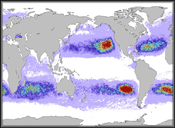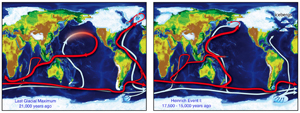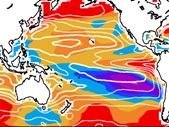Press Releases 2010
Study Could Mean Greater Anticipated Global Warming
November 22, 2010 
Global climate models disagree widely in the magnitude of the warming we can expect with increasing carbon dioxide. This is mainly because the models represent clouds differently. A new modeling approach successfully simulates the observed cloud fields in a key region for climate. The study finds a greater tendency for clouds to thin with global warming than in any of the current climate models. This means the expected warming may be greater than currently anticipated. The study by Lauer et al. is published in the Journal of Climate, Vol. 23, No. 21, 5844–5863.
Threshold Sea Surface Temperature for Hurricanes
and
Tropical Thunderstorms Is Rising
November 7, 2010
Scientists have known that atmospheric
convection in the form of hurricanes and tropical
ocean thunderstorms occurs when sea
surface temperature rises above a threshold. So how do rising ocean
temperatures with global warming affect this
threshold? If it does not rise, it could
mean more frequent hurricanes. The study by IPRC's Nat Johnson and Shang-Ping Xie shows this
threshold
is rising with global warming at the same rate as
tropical ocean temperatures. Their paper appears in
the Advance Online Publications of Nature Geoscience.
UH Scientist Predicts Plastic Garbage Patch in Atlantic Ocean
August 19, 2010
 Where does the plastic garbage in the ocean go? Twenty-two years worth of data collected by undergraduate students aboard a sailing vessel has identified widespread floating plastic debris in the western North Atlantic that
is comparable to the ‘Great Pacific Garbage Patch.’ The study, led by a team of researchers from Sea Education Association (SEA), Woods Hole Oceanographic Institution (WHOI), and the University of Hawaii at Manoa (UHM), is published this week in Science.
Where does the plastic garbage in the ocean go? Twenty-two years worth of data collected by undergraduate students aboard a sailing vessel has identified widespread floating plastic debris in the western North Atlantic that
is comparable to the ‘Great Pacific Garbage Patch.’ The study, led by a team of researchers from Sea Education Association (SEA), Woods Hole Oceanographic Institution (WHOI), and the University of Hawaii at Manoa (UHM), is published this week in Science.
The North Pacific, a Global Backup Generator
for Past Climate Change
July, 9, 2010
 Toward the end of the last ice age, a major reorganization took place in the current system of the North Pacific, which may have buffered the global impacts of the collapsed circulation in the Atlantic, according to a study published by Yusuke Okazaki (JAMSTEC), Axel Timmermann (IPRC) and their international team in the Science. For press release.
Toward the end of the last ice age, a major reorganization took place in the current system of the North Pacific, which may have buffered the global impacts of the collapsed circulation in the Atlantic, according to a study published by Yusuke Okazaki (JAMSTEC), Axel Timmermann (IPRC) and their international team in the Science. For press release.
Going After Regional Climate Patterns
of Global Warming
 February 27, 2010
February 27, 2010
Ocean surface temperatures can be expected to increase mostly everywhere by the middle of the century, but the increase may vary by up to 1.5°C depending upon the region. These emerging ocean temperature patterns in the tropics and subtropics will lead to significant changes in rainfall patterns, according to work by IPRC’s Shang-Ping Xie and colleagues.
News Archive: 2013, 2012, 2011, 2010, 2009, 2008, 2007, 2006, 2004, 2003, 2002, 2001, 2000

